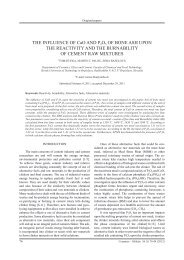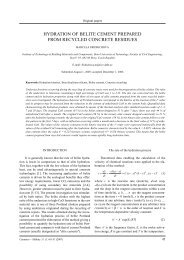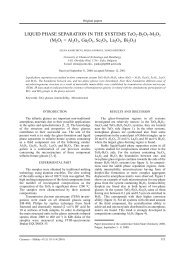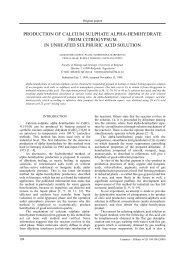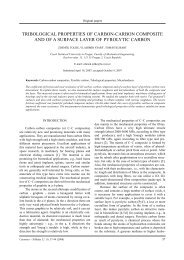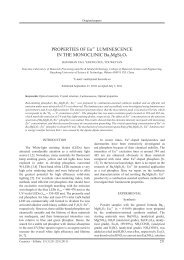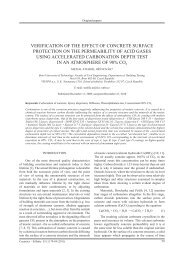behaviour of alumina-spinel self-flowing castables - Ceramics-Silikaty
behaviour of alumina-spinel self-flowing castables - Ceramics-Silikaty
behaviour of alumina-spinel self-flowing castables - Ceramics-Silikaty
Create successful ePaper yourself
Turn your PDF publications into a flip-book with our unique Google optimized e-Paper software.
Original papers<br />
BEHAVIOUR OF ALUMINA-SPINEL SELF-FLOWING CASTABLES<br />
WITH NANO-ALUMINA PARTICLES ADDITION<br />
SASAN OTROJ, REZA MARZBAN*, ZIARAT ALI NEMATI**,<br />
NARGES SAJADI***, MOHAMMAD REZA NILFOROUSHAN<br />
Shahrekord University, Shahrekord, Iran<br />
*Ghadr Refractory Co., Tehran, Iran<br />
**Sharif University, Tehran, Iran<br />
***Islamic Azad University (Science and Research Branch), Tehran, Iran<br />
E-mail: Sasan.Otroj@gmail.com<br />
Submitted August 12, 2007; accepted October 2, 2008<br />
Keywords: Nano-Alumina, Self-Flow, Alumina-Spinel, Castable<br />
The purpose <strong>of</strong> this study is to determine the influence <strong>of</strong> nano-<strong>alumina</strong> particles on the <strong>self</strong>-flow characteristics <strong>of</strong> <strong>alumina</strong><strong>spinel</strong><br />
<strong>self</strong>-<strong>flowing</strong> <strong>castables</strong>. For this reason, the <strong>self</strong>-flow characteristics such as; <strong>self</strong>-flow value and working time <strong>of</strong> the<br />
<strong>alumina</strong>-<strong>spinel</strong> <strong>castables</strong> with different amount <strong>of</strong> nano-<strong>alumina</strong> particles have been studied. Also, the mechanical properties<br />
and microstructure <strong>of</strong> these <strong>castables</strong> have been studied. For the study <strong>of</strong> nano-<strong>alumina</strong> (d50 =4 3 nm) addition on <strong>self</strong>flow<br />
characteristics and other properties <strong>of</strong> these <strong>castables</strong>, reactive <strong>alumina</strong> is substituted by nano-<strong>alumina</strong> powder in<br />
0-4 wt.% range. The results show that the nano-<strong>alumina</strong> particles have great effect on the <strong>self</strong>-flow characteristics and<br />
mechanical strength. With increase <strong>of</strong> nano-<strong>alumina</strong> particles in castable composition, the <strong>self</strong>-flow value and working time<br />
tends to decrease and cold crushing strength is enhanced at all temperatures. By use <strong>of</strong> 1.5 wt.% nano-<strong>alumina</strong> contents in<br />
the castable composition, the <strong>alumina</strong>-<strong>spinel</strong> <strong>self</strong>-<strong>flowing</strong> castable with adequate working time and very high mechanical<br />
strength can be obtained.<br />
INTRODUCTION<br />
Refractory researchers recently started to engineer<br />
the quality <strong>of</strong> advanced <strong>castables</strong> by laying down nano-<br />
sized materials in the composition. Very high surface<br />
energy and rapid diffusion paths usually make the nanoparticles<br />
far more reactive in the refractories, which<br />
frequently encounter the aggressive environment,<br />
particularly in the steel industries. As such, the strength,<br />
thermal shock and corrosion resistance <strong>of</strong> a refractory<br />
castable can be improved if one can favorably tailor the<br />
interaction <strong>of</strong> nano-phases with the other particles [1, 2].<br />
The <strong>self</strong>-flow <strong>castables</strong> are one <strong>of</strong> the interesting fields<br />
for use <strong>of</strong> nano-particles in the refractory <strong>castables</strong>. Selfflow<br />
<strong>castables</strong> are characterized by their consistency after<br />
mixing, which allows them to flow and de-air without<br />
the application <strong>of</strong> external energy (i.e., vibration). It is<br />
easily recognized that the particle size distribution (PSD)<br />
<strong>of</strong> the <strong>castables</strong> is an important factor in improving the<br />
flow ability <strong>of</strong> the mix. The fine and ultra-fine particles<br />
will increase the distance between aggregate particles<br />
and improve flow ability. The main advantages <strong>of</strong> <strong>self</strong><strong>flowing</strong><br />
<strong>castables</strong> in comparison with vibration <strong>castables</strong><br />
are <strong>flowing</strong> and densifying without any external force,<br />
installation easier and less dependant on the skill and the<br />
carefulness <strong>of</strong> the workers, fill complicated or narrow<br />
space, noise-free, saving man-power, time and vibration<br />
facilities and good service performance.<br />
Applications such as monolithic ladle lining, where<br />
pump ability <strong>of</strong> the refractory material is critical for<br />
quick and easy installation, have strongly influenced<br />
the use <strong>of</strong> <strong>self</strong>-<strong>flowing</strong> <strong>castables</strong>. Hence, <strong>alumina</strong>-<strong>spinel</strong><br />
<strong>self</strong>-<strong>flowing</strong> <strong>castables</strong> have been used as steel ladle lining<br />
below the slag line because <strong>of</strong> increasing labor costs and<br />
the severe secondary steel-making environment in the<br />
ladle [3-5].<br />
The present work describes the effect <strong>of</strong> nano-<strong>alumina</strong><br />
particles, which are the extremely fine particles, on<br />
the <strong>self</strong>-flow value, working time, cold crushing strength<br />
and microstructure <strong>of</strong> <strong>alumina</strong>-<strong>spinel</strong> <strong>self</strong>-<strong>flowing</strong> <strong>castables</strong>.<br />
EXPERIMENTAL<br />
Raw materials and composition<br />
The castable composition used for <strong>alumina</strong>-<strong>spinel</strong><br />
<strong>self</strong>-<strong>flowing</strong> castable is listed in Table 1. Also; the<br />
chemical composition <strong>of</strong> raw materials used for this study<br />
is shown in Table 2. The used nano-<strong>alumina</strong> powder<br />
(as reactive type) in this study is product <strong>of</strong> Inframat<br />
Advanced Materials Co. (USA) which, its chemical com-<br />
position and other physical parameters are shown in<br />
Table 3. For the study <strong>of</strong> nano-<strong>alumina</strong> addition on<br />
<strong>self</strong>-flow characteristics and other properties <strong>of</strong> these<br />
98 <strong>Ceramics</strong> – Silikáty 53 (2) 98-101 (2009)
Behaviour <strong>of</strong> <strong>alumina</strong>-<strong>spinel</strong> <strong>self</strong>-<strong>flowing</strong> <strong>castables</strong> with nano-<strong>alumina</strong> particles addition<br />
<strong>castables</strong>, reactive <strong>alumina</strong> is substituted by nano-<strong>alumina</strong><br />
powder in 0-4 wt.% range. The TEM micrograph<br />
<strong>of</strong> nano-<strong>alumina</strong> consumed is shown in Figure 1.<br />
The Particle size distribution was calculated from<br />
the Andreasen‘s equation (1) as follow:<br />
CPFT = 100 × (d/D) q (1)<br />
where CPFT, d, D and q indicate the cumulative percentage<br />
finer than, particle size, the largest particle size<br />
(5000 μm) and the distribution modulus, respectively. In<br />
order to achieve <strong>self</strong>-flow, q values should be in the range<br />
0.21-0.26. The q = 0.24 was considered for the present<br />
study, with respect to our previous investigations [5]. The<br />
particle size distribution <strong>of</strong> the castable with this value<br />
<strong>of</strong> q and without nano-<strong>alumina</strong> particles is represented<br />
in Figure 2.<br />
Self-flow measurement<br />
Self-flow value and working time measurement<br />
was performed according to ASTM C 1446-99. Based<br />
on this standard, after dry mixing <strong>of</strong> the batch for 30 s<br />
in a planetary mixer (Hobart), all the water (distilled)<br />
was added within 10 s while the mixer was running. The<br />
Table 1. Raw materials and composition <strong>of</strong> the studied <strong>alumina</strong><strong>spinel</strong><br />
castable.<br />
Raw materials Source (Type) (wt.%)<br />
Tabular Alumina .. 2-5 mm<br />
............................. 1-2 mm<br />
.......................... 0.5-1 mm<br />
.......................... 0-0.5 mm<br />
............................ ≤ 45 μm<br />
Alcoa Chemicals, T-60 ............60<br />
Spinel ............... 0.5-1 mm<br />
.......................... 0-0.5 mm<br />
White Circle, Spinwhite 78 .....23<br />
Reactive .... d50 = 1.90 μm<br />
Alumina<br />
Alcoa Chemicals, CTC-20 ......11<br />
Cement ...... d50= 3.03 μm Lafarge, Secar-71 ......................6<br />
Deflocculant ..................... S.K.W., Castament FS 10 .......0.1<br />
Table 2. Chemical composition <strong>of</strong> used raw materials.<br />
Oxide Tabular Spinel Reactive Cement<br />
(wt.%) Alumina Alumina<br />
Al2O3 99.4 76-77 99.8 72.7<br />
Na2O 0.36 0.15 0.06 0.19<br />
CaO 0.05 0.3 0.02 26.5<br />
MgO 0.1 22-23 0.02 0.09<br />
SiO2 0.02 0.06 0.03 0.2<br />
Fe2O3 0.1 0.1 0.03 0.01<br />
Table 3. Chemical composition and physical parameters <strong>of</strong><br />
nano-<strong>alumina</strong>.<br />
Al2O3 Specific surface Crystal Loose density Average grain<br />
(%) area (m2 /g) phase (g/cm3 ) size (nm)<br />
99.99 35 α 0.33 43<br />
wet mixing was conducted for 5 min at a slow speed<br />
(Hobart, speed 1). After mixing, the prepared castable,<br />
was transferred to a sealed container and care was<br />
taken to keep the moisture constant. Ten minutes after<br />
addition <strong>of</strong> water, the mixed castable was poured into a<br />
standard cone with a base diameter <strong>of</strong> 100 mm according<br />
to ASTM standard number C-230. The cone was then<br />
elevated to allow the mix to flow, and after 60 s the<br />
patty diameter was measured. The percentage increase<br />
in spreading diameter after 60 s is taken as the <strong>self</strong>-flow<br />
value according to the following Equation (2):<br />
Self-flow (%) = (D2 – D1) ×100/D1 (2)<br />
where D2 is the final average diameter after removal <strong>of</strong><br />
mould and D1 is the initial diameter (100 mm). The castable<br />
is considered as <strong>self</strong>-flow, when the above value<br />
lies within the range <strong>of</strong> 80-110 % <strong>of</strong> the base diameter.<br />
During the <strong>self</strong>-flow evaluation, the ambient temperature<br />
was controlled to be in the range <strong>of</strong> 20-24°C [12].<br />
Figure 1. TEM image <strong>of</strong> nano-<strong>alumina</strong> particles.<br />
10 nm<br />
Figure 2. Theoretical and experimental particle size distribution<br />
<strong>of</strong> <strong>self</strong>-<strong>flowing</strong> castable without nano-<strong>alumina</strong> particles.<br />
<strong>Ceramics</strong> – Silikáty 53 (2) 98-101 (2009) 99
Otroj S., Marzban R., Nemati Z. A., Sajadi N., Nilforoushan M. R.<br />
Castable preparation<br />
In order to make the nano powder distribute evenly<br />
throughout the mixture, firstly, nano-<strong>alumina</strong> powder<br />
was mixed with the reactive <strong>alumina</strong> inside the mini type<br />
ball crusher in a definite proportion for two hours. Then,<br />
the mix compounds were mixed with other raw materials<br />
and water and cast in molds (7 cm 3 ), wrapped in plastic<br />
and cured at room temperature for 24 h. 5.1 wt.% water<br />
amount is added constantly for mixing <strong>of</strong> <strong>castables</strong> for<br />
all compositions. After curing, the specimens were taken<br />
out <strong>of</strong> the mold, dried for 24 h at 110°C and fired at 1000<br />
and 1500°C for 3 h. The cold crushing strength (C.C.S)<br />
<strong>of</strong> the specimens was measured after drying and firing at<br />
each temperature. Cold crushing strength was performed<br />
in accordance with ASTM C 133-97. Mechanical strength<br />
data presented in this article correspond to an average <strong>of</strong><br />
five specimens for each composition and at each firing<br />
temperature.<br />
Microstructural evaluations<br />
The cross sections <strong>of</strong> samples after drying and<br />
firing at 1500°C were evaluated by scanning electron<br />
microscope (SEM). Microstructural evaluations were<br />
performed using Cambridge S-360 SEM at 10-20 kV.<br />
RESULTS AND DISCUSSION<br />
The influence <strong>of</strong> nano-<strong>alumina</strong> on the <strong>self</strong>-flow<br />
characteristics<br />
Figure 3 shows the effect <strong>of</strong> nano-<strong>alumina</strong> particles<br />
content on <strong>self</strong>-flow value <strong>of</strong> the <strong>alumina</strong>-<strong>spinel</strong> castable<br />
as a function <strong>of</strong> time. The results indicate that with increase<br />
<strong>of</strong> nano-<strong>alumina</strong> particles in castable composition, <strong>self</strong><strong>flowing</strong><br />
value tends to decrease.<br />
Figure 3. The influence <strong>of</strong> nano-<strong>alumina</strong> particles on <strong>self</strong>-flow<br />
value <strong>of</strong> <strong>alumina</strong>-<strong>spinel</strong> castable as a function <strong>of</strong> time.<br />
The nano-<strong>alumina</strong> particles have high surface area<br />
that leads to attraction forces between particles. These<br />
attractions between nano-<strong>alumina</strong> particles and other fine<br />
particles in the castable matrix would lead to formation<br />
<strong>of</strong> flocculation structure in which free water is trapped<br />
and flow is decreased. From Figure 3, one can see that<br />
the addition <strong>of</strong> nano-<strong>alumina</strong> particles to the castable<br />
composition decrease working time. Generally, the first<br />
sequence in the setting <strong>of</strong> a castable is loss <strong>of</strong> flow, i.e. it<br />
becomes impossible to place. Control <strong>of</strong> the set time has<br />
always been one <strong>of</strong> the most wanted but also perhaps the<br />
most difficult aspect <strong>of</strong> refractory castable technology.<br />
The proper working time long enough for appropriate<br />
placement <strong>of</strong> <strong>castables</strong> is actually between 30 to 100 min.<br />
Therefore, <strong>castables</strong> containing up to 1.5 wt.% nano<strong>alumina</strong><br />
particles will have adequate working time and can<br />
be installed properly.<br />
The influence <strong>of</strong> nano-<strong>alumina</strong> on mechanical<br />
properties and microstructure<br />
The effect <strong>of</strong> nano-<strong>alumina</strong> particles on cold crushing<br />
strength <strong>of</strong> the castable as a function <strong>of</strong> sintering<br />
temperature is shown in Figure 4. It can be seen from<br />
Figure 4 that cold crushing strength is enhanced considerably<br />
with the increase <strong>of</strong> nano-<strong>alumina</strong> particles<br />
content (especially higher than 0.5 wt.%) after drying<br />
and firing at all temperatures. A very important characteristic<br />
is the strength development <strong>of</strong> a castable. In<br />
practice the higher cold crushing strength leads to the<br />
higher erosion resistance <strong>of</strong> castable and then more life<br />
time. Hence, the <strong>alumina</strong>-<strong>spinel</strong> <strong>castables</strong> must have cold<br />
crushing strength values above 60, 60 and 150 MPa at 110,<br />
1000 and 1500°C respectively. With respect to results,<br />
if the nano-<strong>alumina</strong> particles content in castable com-<br />
position be used higher than 0.5 wt.%, the high-strength<br />
<strong>alumina</strong>-<strong>spinel</strong> castable will be obtained. By using <strong>of</strong><br />
Figure 4. The influence <strong>of</strong> nano-<strong>alumina</strong> particles on the C.C.S<br />
<strong>of</strong> samples as a function <strong>of</strong> firing temperature.<br />
100 <strong>Ceramics</strong> – Silikáty 53 (2) 98-101 (2009)
Behaviour <strong>of</strong> <strong>alumina</strong>-<strong>spinel</strong> <strong>self</strong>-<strong>flowing</strong> <strong>castables</strong> with nano-<strong>alumina</strong> particles addition<br />
nano-<strong>alumina</strong> particles instead <strong>of</strong> reactive <strong>alumina</strong> in<br />
the castable composition, the packing density can be<br />
increased hence, the mechanical strength.<br />
On the other hand, this Figure shows that nano<strong>alumina</strong><br />
particles content over than 0.5 wt.% has great<br />
effect on the strength increasing at 1200°C and higher.<br />
This means that sintering <strong>of</strong> the refractory castable occu-<br />
rred in the lower temperature when nano-sized particles<br />
in the composition are increased (higher than 0.5 wt.%).<br />
Adding nano-<strong>alumina</strong> in high <strong>alumina</strong> refractory <strong>castables</strong>,<br />
the solid phase sintering <strong>of</strong> the nano-sized particles<br />
occurred in the lower temperature because <strong>of</strong> the<br />
difference <strong>of</strong> surface area and special surface area energy<br />
between the matrix particles and the nano-<strong>alumina</strong><br />
particles.<br />
Figure 5. SEM photomicrograph <strong>of</strong> <strong>alumina</strong>-<strong>spinel</strong> castable<br />
containing 4 wt.% nano-<strong>alumina</strong> particles after drying.<br />
Figure 6. SEM photomicrograph <strong>of</strong> <strong>alumina</strong>-<strong>spinel</strong> castable con-<br />
taining 4 wt.% nano-<strong>alumina</strong> particles after firing at 1500°C.<br />
Figures 5 and 6 demonstrate the microstructure <strong>of</strong><br />
<strong>alumina</strong>-<strong>spinel</strong> castable containing 4 wt.% nano-<strong>alumina</strong><br />
particles after drying and after firing at 1500°C. Figure<br />
5 shows high packing microstructure, in which the finer<br />
particles occupy the voids between the coarser particles,<br />
enabling a decrease in the porosity and increase <strong>of</strong> the<br />
density and mechanical strength. It can be seen from<br />
Figure 6 that fine particles in the matrix has grown as<br />
flake shape and interlocked. This led to increasing <strong>of</strong><br />
strength at high temperatures. When the nano-<strong>alumina</strong><br />
particles come into contact with the matrix in the process<br />
<strong>of</strong> sintering, the transference will happen from<br />
nano-sized and fine particles to big particles because <strong>of</strong><br />
the difference <strong>of</strong> curvature radius. In this process, the<br />
particles coursing occurred, which made the surface<br />
energy decreased.<br />
CONCLUSIONS<br />
This study confirmed the strong influence that<br />
extremely fine <strong>alumina</strong> particles exert on the properties<br />
<strong>of</strong> <strong>self</strong>-<strong>flowing</strong> <strong>alumina</strong>-<strong>spinel</strong> <strong>castables</strong>. An attraction<br />
between nano-<strong>alumina</strong> particles and other fine particles<br />
in the castable matrix appears to promote lower flow<br />
ability in this system. Also, the addition <strong>of</strong> nano-<strong>alumina</strong><br />
particles in the castable composition decrease working<br />
time. The results also indicate that the nano-<strong>alumina</strong><br />
particles have a great effect on the green and firing<br />
strength <strong>of</strong> these <strong>castables</strong>. Adding nano-<strong>alumina</strong> in <strong>alumina</strong>-<strong>spinel</strong><br />
castable, the solid phase sintering <strong>of</strong> the<br />
nano-sized particles occurred in the lower temperature<br />
because <strong>of</strong> the difference <strong>of</strong> surface area energy between<br />
the matrix and the nano-<strong>alumina</strong> particles. The best results<br />
are obtained with 1.5 wt.% nano-<strong>alumina</strong> addition which<br />
defines the <strong>self</strong>-<strong>flowing</strong> castable with sufficient working<br />
time and high mechanical strength.<br />
References<br />
1. Mukhpadhyay S., Pal P., Nag B., Jana P.: <strong>Ceramics</strong><br />
International 33, 175 (2007).<br />
2. Janeway P.: Am. Ceram. Soc. Bull. 82, 31 (2003).<br />
3. Ko Y. C.: Ceramic News Special Refractories 6, 51 (2002).<br />
4. de Sousa Resende W.: Ceramic News Special Refractories<br />
6, 57 (2002).<br />
5. Otroj S., Marzban R., Adibi M. B., Nikoo K. A.: Proc.<br />
48 th International Colloquium on Refractories, p.52-55,<br />
Eurogress Aachen 2005.<br />
6. ASTM-C 1446-99: Standard Method for Measuring Consistency<br />
& Working Time <strong>of</strong> Self-Flowing Castable Refractories.<br />
<strong>Ceramics</strong> – Silikáty 53 (2) 98-101 (2009) 101



